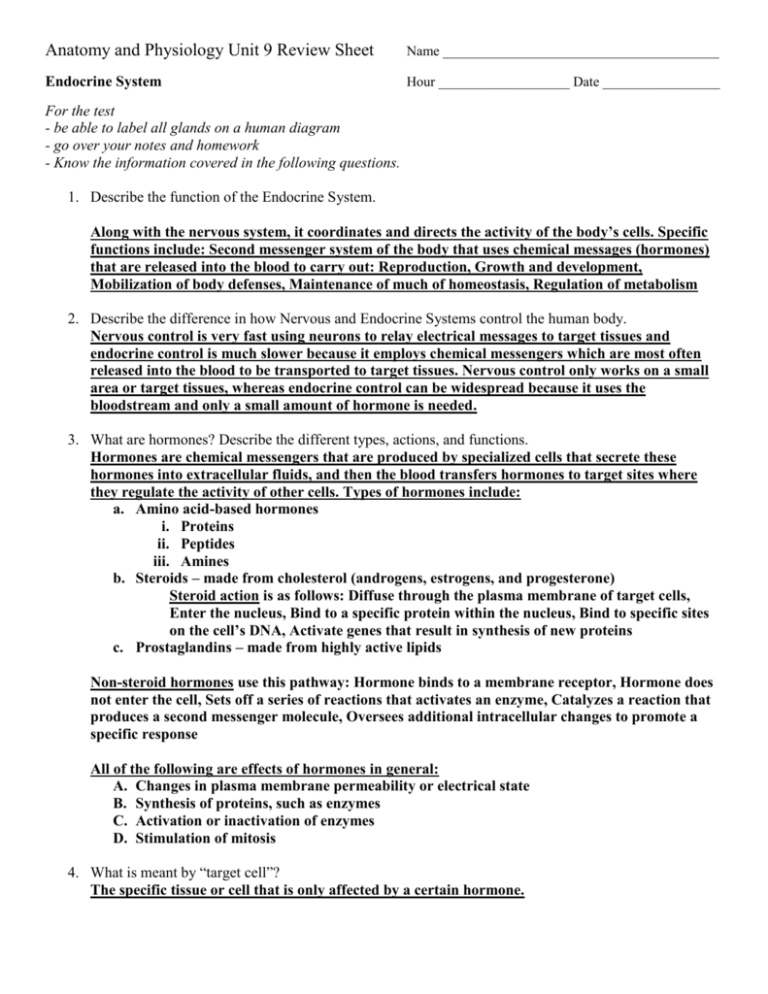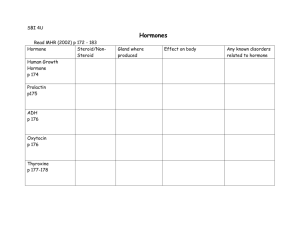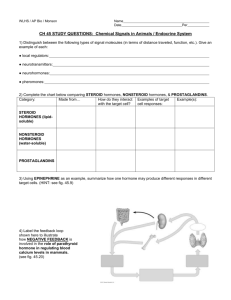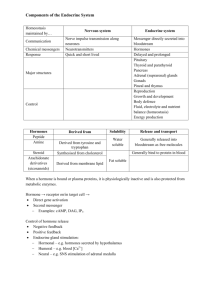Anatomy and Physiology Unit 9 Review Sheet
advertisement

Anatomy and Physiology Unit 9 Review Sheet Name ________________________________________ Endocrine System Hour ___________________ Date _________________ For the test - be able to label all glands on a human diagram - go over your notes and homework - Know the information covered in the following questions. 1. Describe the function of the Endocrine System. Along with the nervous system, it coordinates and directs the activity of the body’s cells. Specific functions include: Second messenger system of the body that uses chemical messages (hormones) that are released into the blood to carry out: Reproduction, Growth and development, Mobilization of body defenses, Maintenance of much of homeostasis, Regulation of metabolism 2. Describe the difference in how Nervous and Endocrine Systems control the human body. Nervous control is very fast using neurons to relay electrical messages to target tissues and endocrine control is much slower because it employs chemical messengers which are most often released into the blood to be transported to target tissues. Nervous control only works on a small area or target tissues, whereas endocrine control can be widespread because it uses the bloodstream and only a small amount of hormone is needed. 3. What are hormones? Describe the different types, actions, and functions. Hormones are chemical messengers that are produced by specialized cells that secrete these hormones into extracellular fluids, and then the blood transfers hormones to target sites where they regulate the activity of other cells. Types of hormones include: a. Amino acid-based hormones i. Proteins ii. Peptides iii. Amines b. Steroids – made from cholesterol (androgens, estrogens, and progesterone) Steroid action is as follows: Diffuse through the plasma membrane of target cells, Enter the nucleus, Bind to a specific protein within the nucleus, Bind to specific sites on the cell’s DNA, Activate genes that result in synthesis of new proteins c. Prostaglandins – made from highly active lipids Non-steroid hormones use this pathway: Hormone binds to a membrane receptor, Hormone does not enter the cell, Sets off a series of reactions that activates an enzyme, Catalyzes a reaction that produces a second messenger molecule, Oversees additional intracellular changes to promote a specific response All of the following are effects of hormones in general: A. Changes in plasma membrane permeability or electrical state B. Synthesis of proteins, such as enzymes C. Activation or inactivation of enzymes D. Stimulation of mitosis 4. What is meant by “target cell”? The specific tissue or cell that is only affected by a certain hormone. 5. What is a tropic hormone? A tropic hormone is a hormone that comes from an endocrine gland and has action upon another gland to release another hormone to exert effects on other body organs and tissues. 6. Explain how a negative feedback system works. How does this illustrate actions of the endocrine system? In the endocrine system, a negative feedback system would be when hormone secretion is triggered by some internal or external stimulus; one hormone levels rise to a certain level, other hormone release is inhibited even while responses in cells are being promoted. Hint: Think of your furnace, it kicks on when it is cold and shuts off when it is warm. All the while, a relatively constant temperature is being maintained. In the same way, hormone concentration has a small range too. 7. What is the difference between an endocrine gland and an exocrine gland? Exocrine glands have ducts through which their secretions are carried to a particular site; endocrine glands release their chemical messengers (hormones) directly into the bloodstream for transport. 8. Fill in the following charts by filling in the requested information with regards to studied glands. Fill in the location, type of hormone released and its action. Name of the Location in Name of the released Action of the hormone Endocrine Gland the body hormone Pituitary Gland In the “Turk’s Growth Hormone (GH) or Stimulates growth (especially of bones Anterior or saddle” of the somatotropin and muscles) and metabolism. Causes fats Adenohypophysis sphenoid bone. to broken down into energy and amino acids to be built into proteins. Prolaction (PRL) Stimulates milk production and maintains Glandular Tissue following childbirth FSH or FollicleStimulates production of ova (eggs) and Stimulating Hormone sperm LH or Luteinizing Stimulates ovary and testes to produce sex Hormone hormones. Triggers ovulation in females. Adrenocorticotropic Regulates endocrine activity of the hormone (ACTH) adrenal cortex Thyroid Stimulating Influences growth and activity of the Hormone (TSH) thyroid Pituitary Gland In the “Turk’s Oxytocin Stimulates contractions of the uterus Posterior or saddle” of the during labor and Causes milk ejection Neurohypophysis sphenoid bone ADH or Anti-diuretic Can inhibit urine production by retaining Hormone water and electrolytes. In large amounts, Nervous Tissue causes vasoconstriction leading to increased blood pressure (vasopressin) Thyroid Gland At the base of Thyroid Hormone (made Major metabolic hormone that requires throat, just of T3 and T4) iodine for healthy function. inferior to adam’s apple Calcitonin Decreases blood calcium levels by causing its deposition on bone; Antagonistic to parathyroid hormone; Produced by C (parafollicular) cells Parathyroid Gland Tiny mass on the posterior side of thyroid gland Parathyroid Hormone Adrenal Cortex Mineralcorticoids (aldosterone) On the top of the kidneys Secrete parathyroid hormone; Stimulate osteoclasts to remove calcium from bone; Stimulate the kidneys and intestine to absorb more calcium; Raise calcium levels in the blood Regulate mineral content in blood, water, and electrolyte balance; Target organ is the kidney Production stimulated by renin and aldosterone Production inhibited by atrial natriuretic peptide Glucocorticoids (Cortisone/cortisol) Adrenal Cortex Adrenal Medulla Pancreas Pineal Gland Thymus Gonads Female On the top of the kidneys On the top of the kidneys Produced in the middle layer of the adrenal cortex Promote normal cell metabolism; Help resist long-term stressors; Released in response to increased blood levels of ACTH These hormones prepare the body to deal with sex/reproduction Androgens Epinephrine/norepinephrine These hormones prepare the body to deal with short-term stress; stimulate Fight or Flight Response in Sympathetic NS. Close but Insulin Behind and lateral to the Glucagon stomach allows glucose to cross plasma membranes into cells from beta cells; lowers glucose level in blood In the roof Melatonin of the 3rd ventricle of brain Upper Thymosin Thorax behind sternum In Estrogen abdominal cavity Helps establish the body’s wake and sleep cycles allows glucose to enter the blood from alpha cells; raises blood levels of glucose Matures some types of white blood cells such as T-lymphocytes; Important in developing the immune system Produced by Graafian follicles or the placenta Stimulates the development of secondary female characteristics Matures female reproductive organs Helps prepare the uterus to receive a fertilized egg Helps maintain pregnancy Prepares the breasts to produce milk Progesterone Gonads Male In Testosterone abdominal cavity or scrotum Produced by the corpus luteum Acts with estrogen to bring about the menstrual cycle Helps in the implantation of an embryo in the uterus Responsible for adult male secondary sex characteristics Promotes growth and maturation of male reproductive system Required for sperm cell production 9. How do hormones help the body maintain homeostasis? They alter cellular activity by increasing or decreasing the rate of normal metabolic processes rather than stimulating a new one. They also stimulate: A. Changes in plasma membrane permeability or electrical state B. Synthesis of proteins, such as enzymes C. Activation or inactivation of enzymes D. Stimulation of mitosis 10. T4 stands for ___Thyroxine____ and T3 stands for ____Triiodothyronine______ 11. What is BMR or basal metabolic rate? the rate at which energy is expended (heat produced) by the body per unit of time under controlled (basal) conditions 12 hours after a meal, at rest. 12. What is goiter? A benign enlargement of the thyroid gland that is caused by deficiency of iodine. 13. What is diabetes insipidus? A disease characterized by passage of large amounts of dilute urine plus intense thirst and dehydration; it is a hypothalamic condition where insufficient amounts of ADH or anti-diuretic hormone is the cause. 14. Explain how non-steroid hormones utilize a second messenger system. What is the first messenger? a. Hormone binds to a membrane receptor b. Hormone does not enter the cell c. Sets off a series of reactions that activates an enzyme d. Catalyzes a reaction that produces a second messenger molecule e. Oversees additional intracellular changes to promote a specific response 1st messenger would be an enzyme that is first catalyzed 15. Explain the difference between humoral, hormonal, and neural stimulation. Hormonal – which endocrine organs are prodded into action by other hormones. Humoral – changing blood levels of ions and nutrients stimulating hormone release. Neural – nerve fibers stimulate hormonal release and the target cells respond to neural stimuli. 16. What are prostaglandins? Local hormones made of highly active lipids found in the cell’s plasma membranes. 17. List the other tissue types in the human body that also have an endocrine function. a. Parts of the small intestine b. Parts of the stomach c. Kidneys d. Heart e. Many other areas have scattered endocrine cells f. Placenta i. Produces hormones that maintain the pregnancy ii. Some hormones play a part in the delivery of the baby iii. Produces HCG in addition to estrogen, progesterone, and other hormones 18. What is menopause? How is it related to the endocrine system? Menopause is brought about by lack of efficiency of the ovaries. Reproductive organs start to atrophy (weaken and lose mass) and a woman cannot bear children. It is related to the endocrine system because it involves the ovary’s production of sex hormones. 19. Looking back to the nervous system unit, what is the function of the hypothalamus? regulates body temperature, water balance, and metabolism. 20. Explain the relationship between the posterior pituitary lobe and the hypothalamus. Release of hormones is controlled by releasing and inhibiting hormones produced by the hypothalamus Hypothalamus produces two hormones that are transported to neurosecretory cells of the posterior pituitary The posterior pituitary is not strictly an endocrine gland, but does release hormones 21. What kind of endocrine problems did our case study, “Chemical Eric,” exhibit? Can you name any of the glands or hormones that were involved? Major gland affected was the pituitary which in turn affected the thyroid, the gonads (testes), and the adrenal glands. He had high amounts of GH which caused acromegaly He had low amounts of FSH and LH and was therefore hairless at first and sterile He had low amounts of TSH because of killed pituitary He had low amounts of ACTH and therefore had differing pain responses because of altered epinephrine and norepinephrine. He had low amounts of ADH and therefore had diabetes insipidus. He had to receive hormone therapy throughout his life because doctors irradiated his pituitary and killed it.








